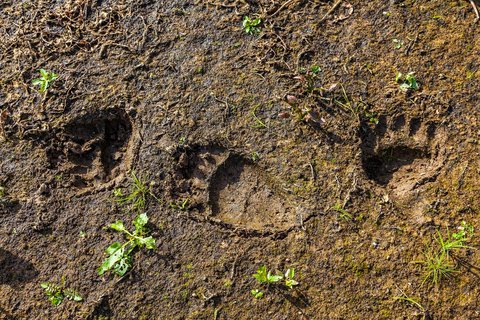Folks that love the woods (or any other outdoor place), usually go there to immerse themselves in nature, play or just relax and take it all in. Avid outdoorsman (and women) realize the importance of awareness. Learning some basic tracking skills is an awesome way to enhance your understanding of who (or what) is out there with you—and, it’s pretty addictive.
Tracking was essential for our ancestors. Knowing how to track kept them safe and well fed. But tracking is much more than a hunter/gatherer skill. It can add more color to our outdoor experience and lead us to discoveries that most people miss. It also allows us to slow down, which is quite a new concept these days. Getting started is pretty easy.
Everyone and everything (maybe not ghosts) leave some sort of track behind. Tracks are everywhere so the first thing you need to do is look. When you find a set, stop, look and listen. Knowing what kind of critters live in the area you’re visiting is a big help but common sense gives you a few basic hints like the size and weight of whatever made the track.
Tracking begins with the first print. If you can figure out which way it went, then it’s time to put on your Sherlock Holmes hat. Zoom out and see if there are any other clues like stomped down grass or sounds. Where might it be going and why? Are there other tracks around? Are they the same? The very first step is to make a general assessment of what you think is happening.
When I teach tracking to beginners, it always amazes me at how good they are at playing detective. Although I offer a few hints, almost everyone finds clues that other folks miss. Awareness is vital but imagination really helps. The deeper you look into the picture, the more it will reveal. And speaking of pictures, most of us carry our cell phones. Take a picture of the track and even the surroundings so you can go home and look it up.
If you really want to learn about tracks, get a good book. One of my favorites is The Trackers Field Guide by James Lowery. The reason I think this is a good book for beginners (and even seasoned trackers) is that it includes pictures of tracks in different conditions (like what the tracks look like in the snow compared with the mud). Learning about the tracks you have seen ultimately makes it easier to find them next time you’re out.
For a great online resource try NatureTracking.com.
Someone in our area posted a track on Facebook warning of a possible mountain lion in the area. Although we have cougars here, it was a large dog track. Ironically it was one of our young students that responded to the post, describing the distinct differences between the two. Wouldn’t it be nice to know that info if you’re hiking in mountain lion country? Trackers do!
So while most people won’t go for their advanced tracking certificates, all of us can learn tracking. It can greatly enhance your experience in nature and is a lot of fun. Slow is the word of the day when you’re tracking. The more you look, the more you’ll find and you may find something that everyone else misses. I’ve watched people walk right by big bear tracks. That would be nice to know if you’re in grizzly country!
ALSO READ: The Art of Animal Tracking
© Sergey Belov | Dreamstime.com – Fresh tracks of a wild bear on the banks of the river








